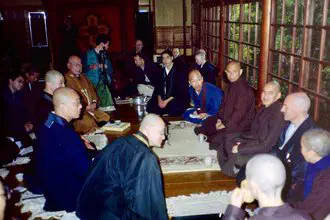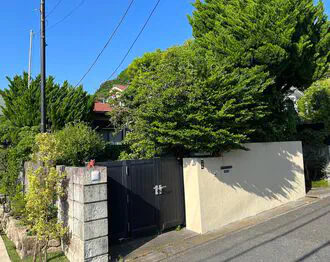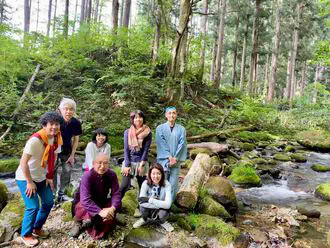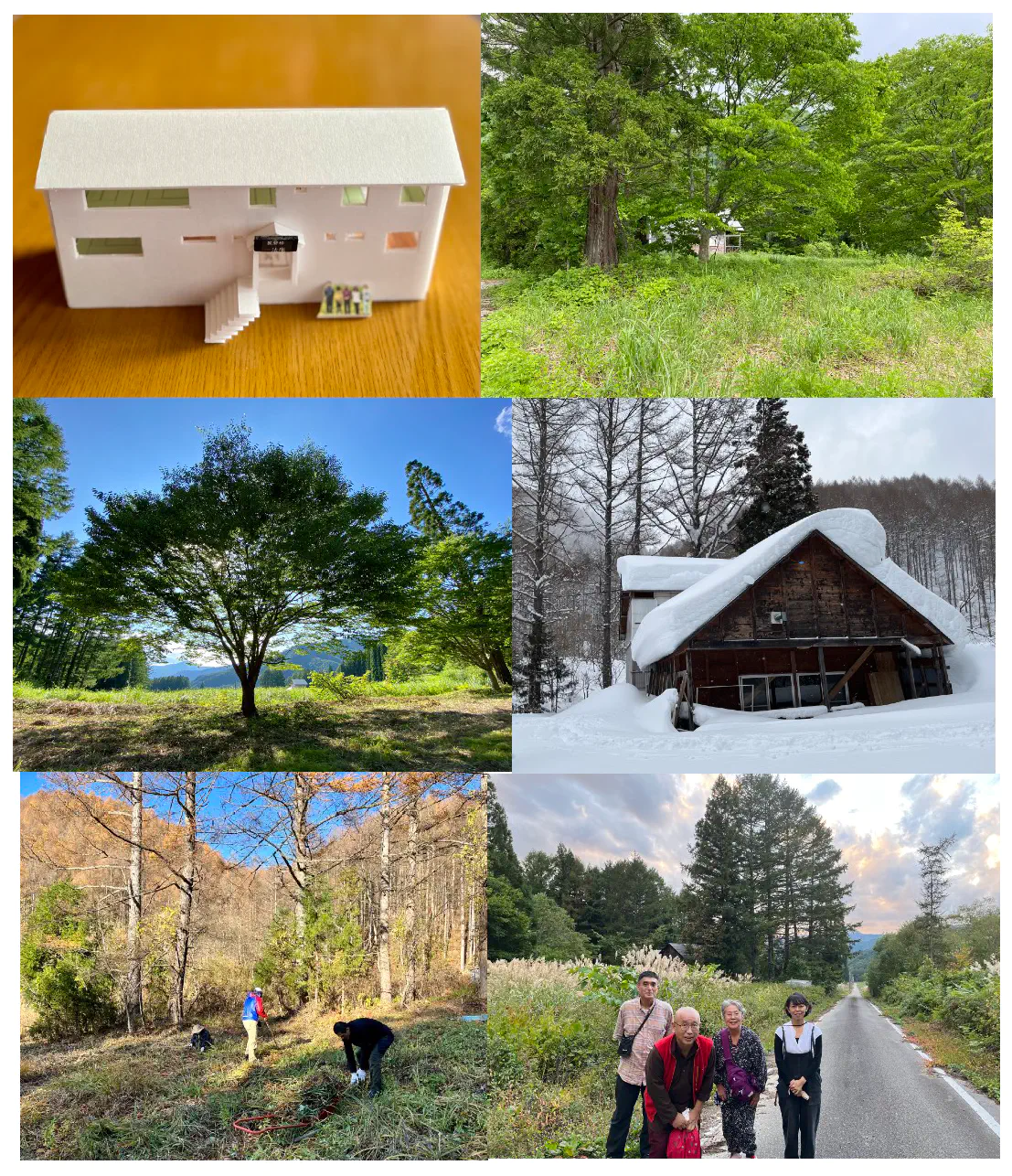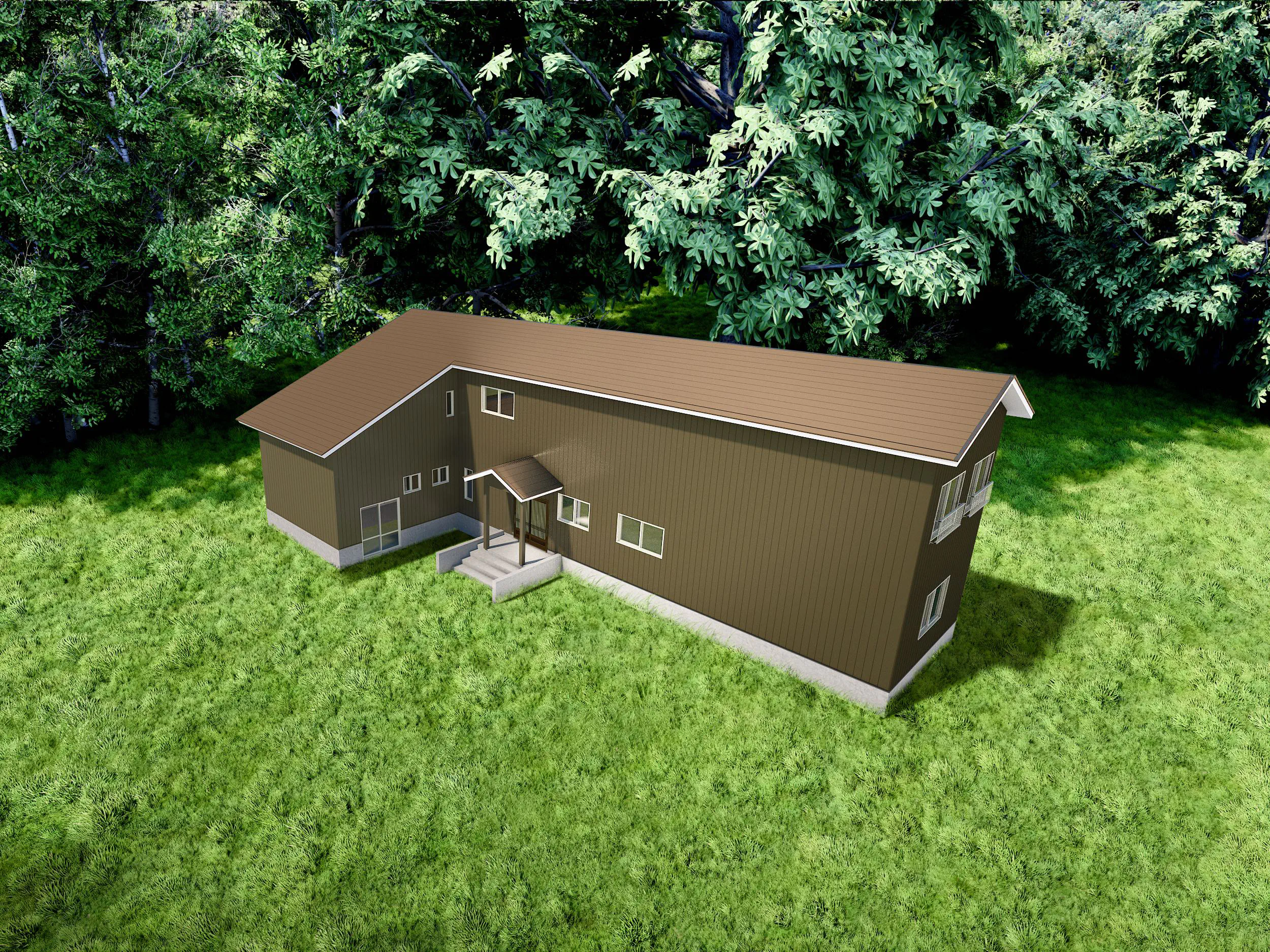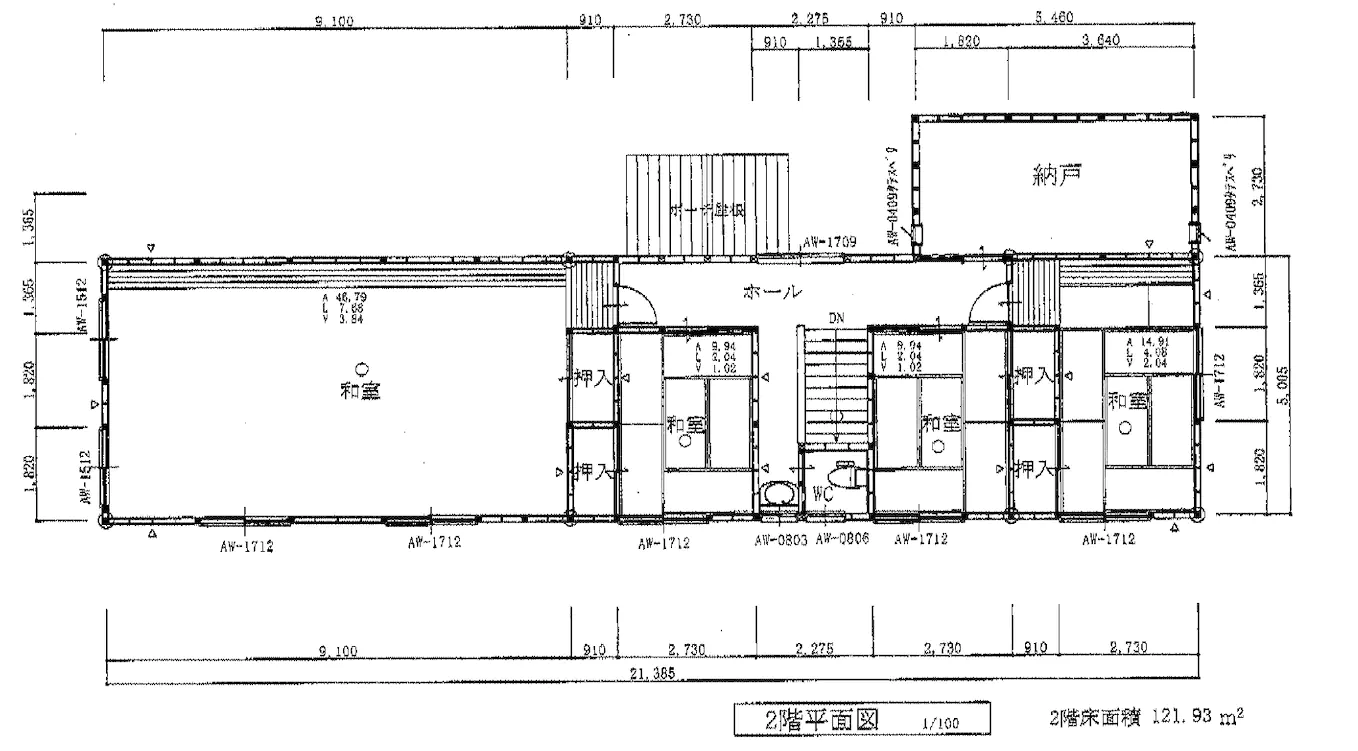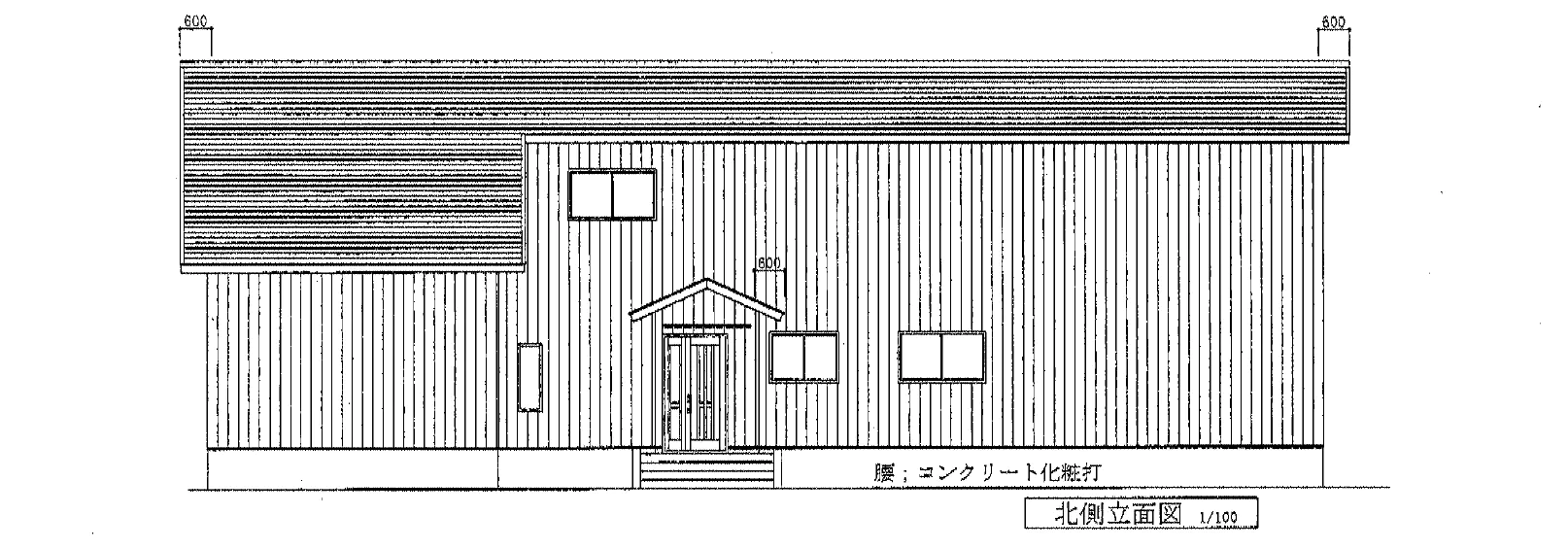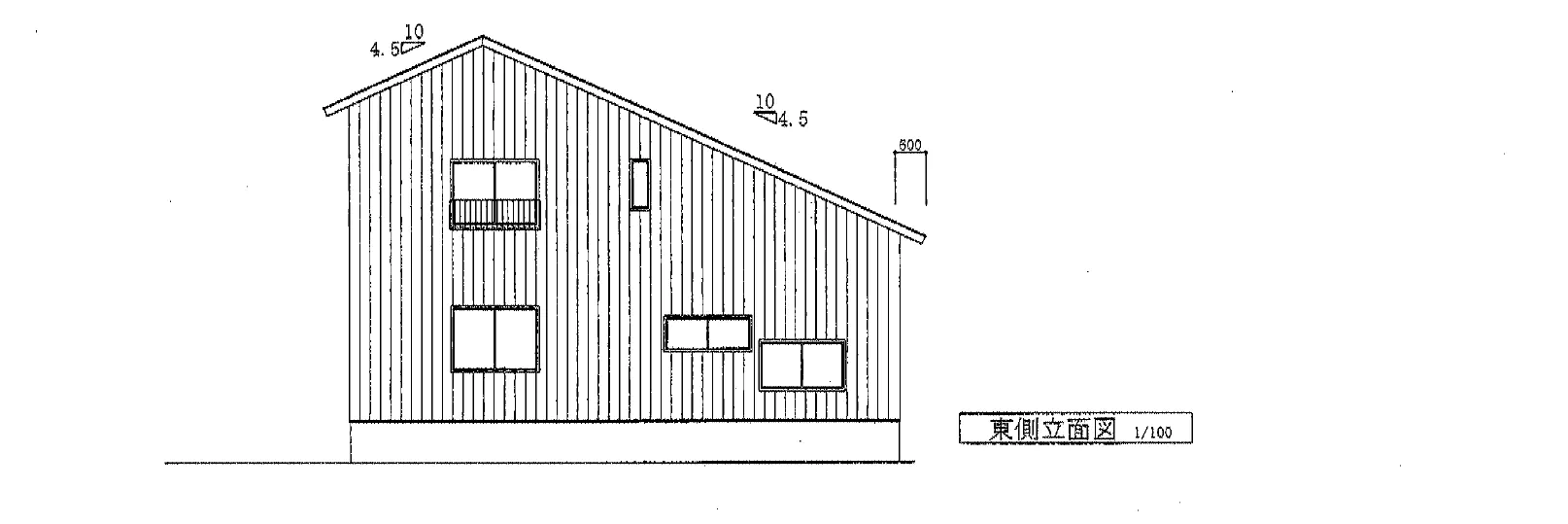Message from the Abbot
September 15, 2022
Dear Dharma friends
Whether you are new to or long-acquainted with us, greetings! As the abbot of Ippoan (pronounced as i-ppo-an), a Buddhist temple in Kamakura, Japan, I have exciting news to share with you.
The new retreat center, Urabandai Ippoan Project has officially begun. The new center aims to serve as a place of hope for those who feel lost in a world filled with suffering. I aspire to offer a place of the Dharma where you can restore your will and energy to carry on your life full of hope through various mindfulness practices.
The home of the new center, 裏磐梯一法庵 (Urabandai Ippoan in Japanese), One Dharma Forum, Urabandai, is Kitashiobara Village, named as one of the 100 Most Beautiful Villages in Japan, where you can practice the Dharma in the pristine nature of North-East Japan. Urabandai in the name refers to the north side of Mt. Bandai in Aizu region of Fukushima Prefecture. With the new retreat center, Ippoan will have two locations, and the existing Ippoan will be called 鎌倉一法庵(Kamakura Ippoan in Japanese), One Dharma Forum, Kamakura. I sincerely hope for your continued support for Ippoan in both places.
You may be curious about the name Ippoan. Ippoan (一法庵)means 庵(Hermitage)of 一(One) 法(Dharma) thus, we call the temple as well as its Sangha as Ippoan and One Dharma Forum interchangeably. Furthermore, Ippo-One Dharma represents my aspiration that my teaching will allow us to return to the teaching of the Buddha before it branched out into different traditions.
As you all know, Prince Siddhartha found the way out of life’s suffering –birth, aging, sickness, and death and became the Buddha after six years of search that was full of hardship. This “way out”, an emergency exit to a world without suffering, which is also called Nirvana or Paradise, is at the heart of Buddhism.
Later, as Buddhism spread from India to other parts of Asia, it blended into the culture of the places it touched upon, giving rise to many traditions, such as Mahayana Buddhism in East Asia, Theravada Buddhism in South Asia, and Tibetan Buddhism, with further subdivisions in each of them. But the Buddha’s teaching was originally one. To return to this one teaching, 一法 ( Ippo), is the founding aspiration of Ippoan-One Dharma Forum.
The aspiration is also my conviction. Zen and Mindfulness, combined together, give rise to a direct pathway to the “emergency exit” that the Buddha discovered. This is what I realized after more than 20 years of practicing Shikantaza (只管打坐, “Just sitting” Zen) in Japan’s Soto-Zen tradition as a Zen monk and intensive study of Theravada’s meditation (Shamata and Vipassana) also as an officially ordained Theravada monk in Myanmar. How come I came to study both traditions as an officially ordained monk in both traditions? I felt as if great forces were at play, which I can only describe as fate. In any case, I am convinced that the two traditions, beyond the superficial differences, need each other.
I have compiled that path into "One Dharma Meditation Method”, which anyone can practice and realize the “emergency exit”, a sure way to a world completely free of suffering. I am confident that Urabandai Ippoan-One Dharma Forum, Urabandai will be an ideal place to study and practice this method, for which you will need a certain amount of time and quietness in order to yield the result.
The COVID-19 pandemic and Russia’s aggression upon Ukraine are just the newest reminders that this world is nothing but a ”house on fire” as the Buddha described. Let's quickly evacuate to a safe place through the “emergency exit”. Now is the time to raise the last and final light of hope high in the sky.
We hope you will join us in making the place of hope, our Urabandai Ippoan-One Dharma Forum, Urabandai, into reality.
Sincerely,
Ryodo Yamashita (Suddhammachara Bhikku)
Abbot of Ippoan-One Dharma Forum;
Leader for the new retreat center project
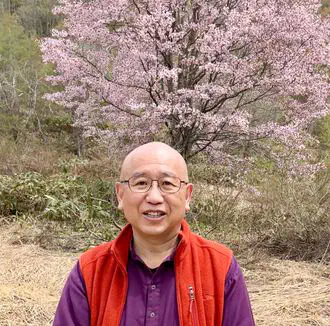
Ryodo Yamashita, Sudhammacara Bhikku, the abbot of Ippoan in Kamakura
Brief Biography
BA in French Language, Tokyo University of Foreign Studies
- 1983 Ordained as a Soto Zen priest at Antaiji Temple.
- 1988 Began serving as a missionary monk of Soto-Zen school. Taught Zen at the Valley Zendo, Massachusetts in the United States and also in Italy. After returning to Japan, he taught Zen at the Kyoto Soto Zen Center as well as Keisei Zendo.
- 2001 Ordained as a Bhikkhu of Theravada Buddhism at Pa-auk Forest Monastery in Myanmar and completed the Pa-auk Meditation Method in 200?.
- 2006 After further studying in Sri Lanka and Nepal, returned to Japan.
Since then, he is based in Ippoan in Kamakura and has taught meditation throughout Japan and in India, Taiwan. He calls himself, "One Dharma Buddhism” Priest.
Publizations
Single authored:- 青空としてのわたし(Blue Sky Me)*
- 本当の自分とつながる瞑想入門( Introduction to Meditation to Connect with True Self)*
- 光の中のマインドフルネス(Mindfulness in the Light)*
- マインドフルネス✖️禅 であなたの雑念はすっきり消える(Mindfulness ✖ Zen" to Clear Your Mental Clutter)*
- 本当の自分とつながる瞑想(Meditation to Connect with True Self)*
Co-authored:
*Currently available in the Japanese language onlyBackground, progress and prospects of the new retreat center
The construction of the new center has already begun. The location is an area called "Urabandai" on the north side of Mt. Bandai in Aizu, Fukushima Prefecture. Here you can learn how the project came to be, the progress so far, and plans toward completion.
Background:
My journey as a Buddhist monk started on April 8th, 1983. I was ordained a a Soto Zen monk at the Antaiji Temple in Tajima, Hyogo Prefecture, Japan and after devoting myself to the practice of 只管打坐(Shikan taza, “Just Sit” zen), I was sent to the United States as a missionary priest of Soto Zen school. I taught Zazen to Americans at the Valley Zendo in Massachusetts for about three years and briefly in Italy. After returning to Japan, I taught Zazen at the Kyoto Soto Zen Center and Keisei Zendo in Kochi, Japan.
May 1995. Dialogue with Thich Nhat Hanh in Kyoto, Japan
The turning point came in March 1995 when I was devastated by the sarin gas attack on the subway and the fact that it had been committed by a religious group. I met with Rev. Thich Nhat Hanh in Kyoto shortly thereafter and was convinced that the teaching of mindfulness, which he had taught us directly, was the key to shake up Japan’s Buddhism which was debunked as pitifully powerless by failing to prevent people from being drawn to the cult group. Then, I started learning Theravada Buddhism in which mindfulness (sati) is the main teaching. In 2004, I went to Myanmar, the home of Theravada Buddhism and became a fully ordained Theravada Bhikku. Then, I went through intensive study and practice of the meditation methods of Theravada tradition under the guidance of Pa-Auk Sayadaw, the prominent meditation master, for four years. At the last stage of my study, I encountered something extraordinary, which I often call “a mysterious X”. It was like a UFO encounter, and after returning to Japan in the summer of 2006, I devoted myself to exploring this “mysterious X”.
The home base to the exploration is the current Ippoan, a small hermitage that my late father built in hopes to support my activities as a monk in the future. It was built in 1985 and my father would stay there when he needed space for contemplation or some quietness. The time when he became unable to visit the hermitage due to old age coincided with my return to Japan, and that is how I took over. Based in Ippoan in Kamakura, I have travelled to many places to deliver teachings all over Japan and beyond. I have taught in India, Taiwan, Korea, and other countries. In each place, I met people of various backgrounds, meditated with them, and deepened my understanding of Dharma through heart-to-heart dialogues.
foreground view of Ippoan in Inamuragasaki, Kamakura
As time goes by, the Sangha grew with both their practice and a deepened understanding of the Dharma. It calls for a place suitable not only for weekly one-day meditation classes but also for long-term retreats. Current Ippoan as a temple is a small house. Meditation classes on the weekends are manageable, but 5-day retreats are challenging. We have managed the monthly 5-day retreats with the help of a good-hearted friend, vegetarian chef Ms. Mari Fujii, who offered accommodation to retreat participants. Still, it is beyond the capacity of Ippoan to accept many people. Therefore, we hold most of the 5-day retreats by renting lodging in rural areas of Tokyo and so on.
Witnessing how our Sanga grows not only in Japan but also abroad, I believe it is time to have a place that allows us to organize more teaching opportunities. Temples or retreat centers are instrumental to deepening the study of the Dharma or spreading the teaching to the greater world. Just as existing Buddhist schools have their centers, One Dharma Buddhism, too, needs its own place spacious enough to accept many seekers not only in Japan but also from abroad. I wish to build such a place in the bounty of nature.
Why Fukushima?
Fukushima became world-famous after the Great East Japan Earthquake in 2011. When we were looking for something we could do in order to support the disaster-stricken Fukushima, we came up with the idea to have a retreat and invite affected people. A friend of mine in Taiwan (Mr. Steve Chang, founder of Trend Micro) generously offered to support that idea. We immediately searched for a suitable location for it and found Yururi, a guest house in Kitashiobara Village. Since then, a retreat in Yururi has become a part of our tradition. For more than ten years, we kept returning to the lovely inn to hold a retreat every June. In December 2020, we held a retreat in Fukushima for the first time in winter, and we loved it. Surrounded by the serene nature of North-East Japan, every single season there is breathtakingly beautiful. It led us to believe that this village is an ideal place for our new retreat center.
Walking meditation along the Azuma River scenic route
About the place
Thus began the search for a land suitable for our new retreat center. After the June Retreat in 2021, we walked around the village and it was there: an old cottage at the entrance of the national forest. At a glance, it was clear that no one visited or used the place for many years. When we contacted the owner, indeed he had not used it for decades and wanted to sell it off. Thanks to the generous donation of our friend, we were able to purchase the land in July 2021.
The old cottage, however lovely, was unfortunately unusable. It was more than 30 years old and damaged by wind, rain, and snow. Thus we are going to tear it down and build a new one. Essential utilities such as water and electricity will be in place. The electricity provider had instilled the necessary poles to deliver energy to the site and we already have had the well dug up.
The site is approximately 2300 ㎡. To the south is a mountain stream called Azuma River, and beyond that is a forest. A driveway connecting to the main road of the village runs along the north side of the property. The building of the center is designed to have all its rooms facing south. At the same time, the building will be highly airtight and insulated to keep the inside warm even with heavy snowfall.
Its Dharma Hall, which is the heart of the center, is about 40.5㎡. It also has a multi-functional room of about 24.3 ㎡ to be used for yoga, meals and meetings. "Make it practical" was our mantra when designing the building. There will be dorm space, multiple washrooms, bathrooms, and a large storage area in order to accommodate a large number of guests.
We are committed to making sure that the new center, Urabandai Ippoan, will be the place of hope that overcomes any darkness in the world. Looking forward to working with you in making our center into reality.
Thank you very much for your support.
Ven. Ryodo Yamashita, Sudhammacara Bhikkhu
Abbot, Kamakura Ippoan / One Dharma Forum, Kamakura
Project Details
Planned construction site
Address
The address of the proposed construction site is here.
Address : 1048-33, Naranoki Dairahara, Hibara, Kitashiobara-mura, Yama-gun, Fukushima 966-0501, Japan
Fukushima Prefecture is divided into three regions: Hamadori, Nakadori, and Aizu. Urabandai Ippoan is located in the Aizu region. When Mt. Bandai erupted in 1888, many lakes and marshes were created. The largest of these lakes is Lake Hibarako. To the north of Lake Hibarako is the community of Wasezawa. Just before the village road that runs east of the village enters the Water resource Forest, you will find Urabandai Ippoan. It is in Bandai-Asahi National Park.
Telephone : There is no landline yet. Please contact Ippoan in Kamakura for phone calls. For the time being, please send mail, etc. to Ippoan in Kamakura. Please refer to the contact information below.
Map :
・The location indicated by the red pin icon is the planned construction site of Urabandai Ippoan.
・To zoom in or out on the map, click on the "+" or "-" symbols in the lower right corner.
・To zoom in or out, click on the "+" or "-" symbols in the lower right corner of the map. Please take a look at the "Aerial Photo" layer. You can see the surrounding natural environment.
The location of the red pin is the proposed construction site of Urabandai Ippoan. It is in the southern part of the Tohoku region. Equidistant from both the Pacific Ocean and the Sea of Japan. It is neither near nor far from Tokyo.

Photo
Around Urabandai Ippoan
Click on the image to enlarge (click on the enlarged image to enlarge further).
| Above left: Original model of Urabandai Ippoan (changed afterwards) | Above right: fresh green season (June) |
| Middle left: Beyond the zelkova tree is a field (August) | Middle right: The previous owner's house buried in snow (February) |
| Bottom left: Mowing work (November) | Bottom right: Village road from the forest goes from east to west (October) |
Four seasons in Urabandai Ippoan
Click on the images below to open the Google Photos shared album "Four Seasons in Urabandai Ippoan". Click on any of the photos in the album to enlarge the image, and use the left and right keys on your computer to view the photos in order.
Aerial View
You can enjoy aerial view of the project site.
It is a Youtube Playlist. The next video will be played automatically.
(You can choose a video to play by clicking the upper right corner ![]() .)
.)
Click here to open it in a separate window.
Blueprints
3D Rendering (Exterior Perspective)
3D image Production: Alleyt Inc.
CG perspective is inserted into a landscape photograph. The colors and textures of the galvalume and metal siding to be used for the roof and exterior walls have been reproduced.
This is a tentative completion drawing. The building is quite close to the real thing, but the surrounding atmosphere is a little different. Please wait until the building is completed realistically. Then you will see the real Urabandai Ippoan.
Click on the image to enlarge.
Southeast side:
Northwest side:
Floor Plan, Elevation
Design: Hirofumi Maeda First-Class Architect Office
Click on the images to enlarge them, and use the left and right keys on your computer to view the images in sequence (click on an enlarged image to enlarge it further). The following is a list of the buildings
Floor Plan :
1st floor |
2nd floor
Elevation :
South side |
West side |
North side |
East side
Design meeting with the architect (Feb 1, 2022)
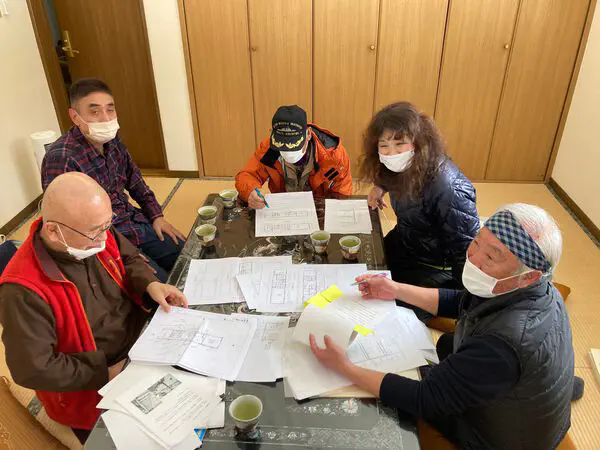
As Ippoan, we have been holding monthly retreat for more than ten years, so we had a common
understanding of what kind of facilities were needed for a dojo where many people would stay. When
we stood on the proposed site, the building of "Urabandai Ippoan" naturally appeared inside of us.
From January of 2022, within the Ippoan Sangha, we began to study the specific floor plan of
the dojo. On February 1, we submitted the draft to Hiroshi Maeda (front right), a first-class
architect. After appropriate revisions by Mr. Maeda, the official design drawings were completed.
The site is located in a national park and is subject to strict building regulations under the
Natural Parks Act, but building permission has already been granted. Construction work can begin at
any time.
<Objectives>
An earthquake-resistant, highly airtight, highly insulated, ventilated, and moisture-permeable house
that is tolerant of the sun and snow.
In other words, we aim to create a house that is sunny, earthquake resistant, warm in winter, cool
in summer, well ventilated, with moderate humidity, where you can enjoy the changing seasons and
lead a healthy life.
Request for your joyous giving
How to Donate
If you agree with the philosophy of the Urabandai Ippoan construction project and would like to work with us to build the "Last Hope Place", we would greatly appreciate your support. There are many ways to support the project, but we would be grateful for your initial donation of construction funds.
We have several ways to donate. Please choose the method that is most convenient for you.
You can wire your donation to the following account:
| Currency | USD |
|---|---|
| Beneficiary Bank | MUFG Bank, LTD. |
| SWIFT code / BIC code |
BOTKJPJT Note: If an 11 digits code is requested, use BOTKJPJTXXX |
| Branch Name | Kamakura Branch |
| Branch Address | 1-5-4 Komachi, Kamakura-shi, Kanagawa 248-0006 Japan |
| Beneficiary Account Number |
255-0145043 |
| Beneficiary Name | RYODO YAMASHITA |
| Beneficiary Address | 1-9-32 Inamuragasaki, Kamakura-shi, Kanagawa 248-0024 JAPAN |
|
Purpose of transfer (if requested by your bank) |
donation |
About the Honorary Founder
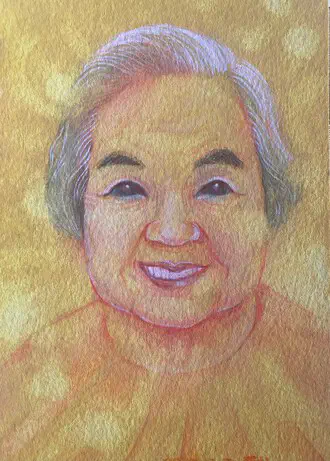
・Honorary Founder of Ippoan, Kamakura Ippoan, Mr. Yoshiaki Yamashita
・Honorary Founder of Urabandai Ippoan, Ms. Seiko Yamashita
Traditionary in Japan, a priest of high virtue is appointed as the first abbot when a new temple is built. This priest is called "開山/Kai-san (founder). On the other hand, the person who funded the construction of the temple is called "開基/Kai-ki(patron/supporter). For Kamakura Ippoan, the founder is Venerable Dr. Rigyo Iida, a prominent scholar of Ryokan poetry while the patron was Yamashita-sensei’s late father, Mr. Yoshiaki Yamashita.
As for Urabandai Ippoan, which will be built with donations from many people, the late mother of Yamashita-Sensei is planned to be named as an honorary supporter for she was the biggest supporter of Yamashita-sensei since he began the journey into Buddhism.
<Ordination ceremony at Antaiji Temple> April 8th, 1983. Taken at the ordination ceremony for my Dharma brother Ven. Issho Fujita and Ven. Ryodo Yamashita. The two people on the right in the front row are Yamashita-sensei’s parents.
<Ceremony of sanctifying ground at Ippoan in Kamakura> The ground-breaking ceremony on May 10, 1985. Yamashita-sensei’s late father, Mr. Yoshiaki Yamashita, is on the far right. In November of the same year, a temple dedication service was held to celebrate the completion of the building.
<Breakfast at Valley Zendo>
September 11th, 1989. Yamashita-sensei’s late mother visits Valley Zendo with her friend.
<Offering to Pa-auk Seyadaw> November 10th, 2002. Yamashita-sensei’s parents visited Myanmar. During their stay in Yangon, they made an offering of the robes to Pa-auk Sayadaw.
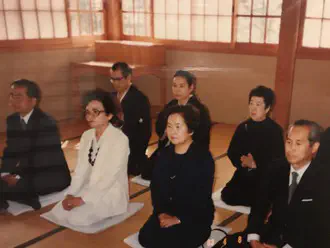
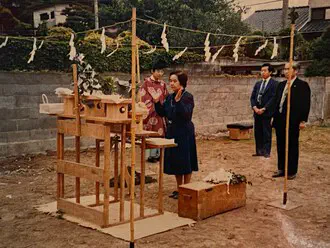
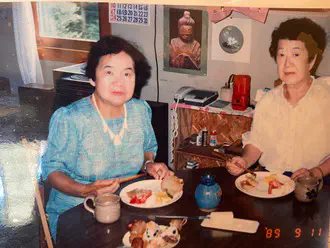
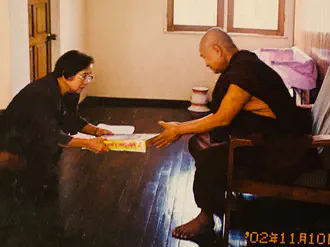
Inquiry
<Representative> Ryodo Yamashita, Sudhammacara Bhikkhu
Address:1-9-32 Inamuragasaki, Kamakura-shi, Kanagawa 248-0024
JAPAN
Phone number:81-80-4154-3637 (Yamashita's cell phone)
81-467-25-3637 (fixed line)
E-mail address:sudhammacara@gmail.com
Please contact us by email if at all possible.
Project Progress
We will continue to report on the progress of the project here, with plans to dig a well and demolish an
old house in June.
Click "+" to open each article.
Water and electricity are the most important infrastructure–we need them for our center and the construction of it. From June 1st to 7th, the long-awaited drilling of the well took place. Since the drilling coincided with our annual retreat in the village of Kitashiobara, we were able to witness the moment when the water spurted out from the underground. The well reached up to a depth of 30 meters underground, which secured enough groundwater in terms of both quantity and quality. The motor for the pump was installed above ground.
According to Yamashita Sensei the water is very tasty. He says it is by far the best-tasting water in Japan, and he is not exaggerating. He brought the water to his home in Kamakura and was pleasantly surprised by how it made a cup of coffee so delicious despite that he used the same coffee beans as usual. The result was the same for Japanese green tea. Water does make difference. Taste it for yourself when you visit.
Of course, the water must be tested for 51 water quality standards set by the Japanese government. When we pass the water quality test, we can serve it as drinking water at the new center.

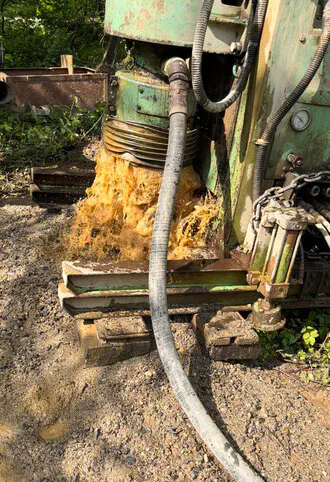
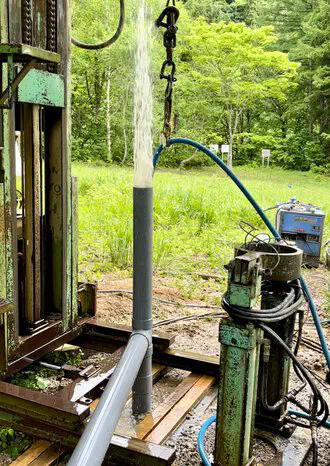
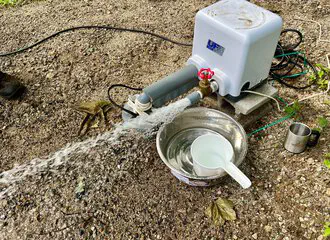
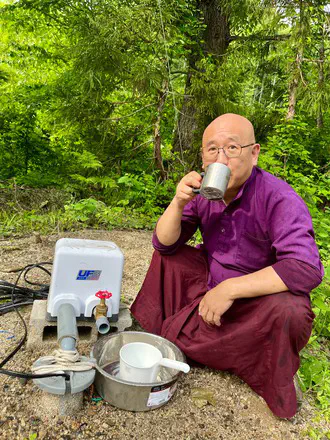
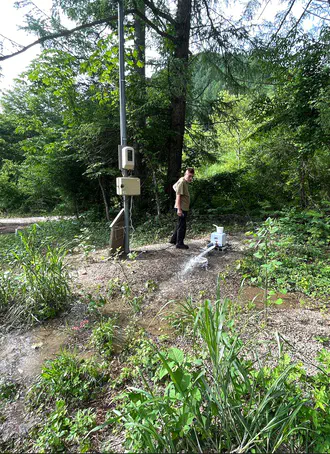
The old cottage on the site for the new retreat center was standing on its last leg. It was damaged by years of wind, rain, and snow. In order to clear the space, we had it torn down. The demolition work started on June 25. We witnessed the work on the 28th and 29th.
When we arrived at the site on June 28th, the upper half of the old building was already gone. There were about five people working there and their leader was tearing the building apart with heavy machinery. The next day, the work started around 9:30 am. Before we knew it, everything but the foundation was gone. The lumber was loaded onto a truck and cleared away. Some trash left by the previous owner was carried away as well.
In the afternoon, the foundation was also gone. Septic tanks, drainage pipes, and water pipes were also dug out and picked up one after another. After loading everything on the truck, the workers carefully cleared the ground. The site is now completely cleared and leveled. It is ready for the installment of the foundation.
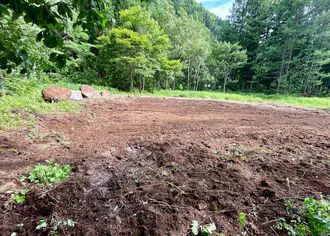

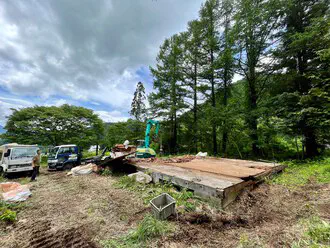
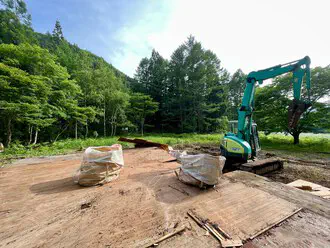
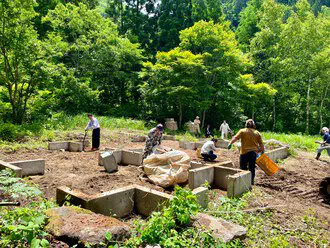
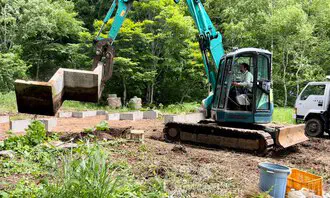
Toward "Ippoan Religious Corporation
Currently, we do not have official status as a religious group registered with authority; however, we aim to obtain an official designation from the government.
The table below maps out the position of Ippoan as a religious group in reference to other traditions of Buddhism.


